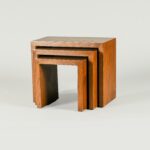Get ready to embark on a journey through time as we unveil the untold historical facts about furniture making. In this article, we will delve into the rich tapestry of the past, exploring the evolution and cultural significance of this timeless art form. With a seasoned craftsmanship enthusiast and writer at the helm, armed with a deep-rooted passion for history, you can expect to uncover hidden gems about traditional woodworking techniques, restoration, and preservation of historical furniture pieces. Prepare to be captivated by lesser-known facts and fascinating anecdotes that will transport you to a bygone era where craftsmanship reigned supreme. Join us as we unravel the secrets of furniture time travel and step into the intriguing world of the art of furniture making.

Historical Facts About Furniture Making
Welcome to a journey through time as we delve into the fascinating world of furniture making. In this article, we’ll uncover the untold historical facts that have shaped this timeless art form. From humble beginnings to intricate masterpieces, furniture has played an integral role in human civilization. So, buckle up and get ready for a furniture time travel like no other!
Prehistoric Times: From Natural Objects to Basic Furniture
Let’s kickstart our journey by rewinding back to prehistoric times. In these early periods, our resourceful ancestors made use of natural objects as rudimentary pieces of furniture. From tree stumps serving as makeshift seats to rocks used as primitive tables, they ingeniously utilized their surroundings to fulfill their essential needs.
Fun Fact: “Did you know that ancient furniture has been excavated from various archaeological sites? One remarkable discovery includes the 8th-century BCE Phrygian tumulus in Gordion, Turkey, where a wooden couch and a shower of other furniture items were unearthed from one of the largest burial mounds in the world.”
Middle Ages to Modern Times: Evolution of Furniture Design
As civilizations advanced, so did the art of furniture making. The middle ages witnessed the popularization of chairs among the nobility, while the general population began to embrace chairs during the Renaissance. Furniture making truly blossomed in the 17th and 18th centuries, with master craftsmen showcasing their skills in creating intricate and ornate pieces.
Insightful Fact: “The evolution of furniture design can be traced back to different periods in history. We can identify distinctive styles during 3000-300 BCE, 500-1550 CE, and 1567-1900 CE. Understanding these timelines helps us appreciate the diverse influences and cultural shifts that have shaped furniture making over the centuries.”
Ancient Civilizations: Greek, Roman, and Beyond
Ancient civilizations such as the Greeks and Romans also made their mark on furniture design. The Greeks favored elegant simplicity, crafting pieces that exuded grace and proportion. Roman furniture, on the other hand, showcased opulence and grandeur, often adorned with intricate carvings and luxurious materials.
Takeaway: “Through the annals of history, we discover how cultural influences impacted furniture design. The ancient Greek and Roman civilizations imparted their unique flair, lending us inspiration for modern-day creations.”
A Tapestry of Styles: From Classic to Contemporary
Furniture has experienced a rich tapestry of styles as human tastes and preferences evolved. From the opulent baroque period to the sleek lines of the art deco movement, each style reflects the spirit and aesthetics of its time. Today, we witness a fusion of past influences and contemporary innovations, resulting in an eclectic mix of designs that cater to diverse tastes.
Key Point: “The ever-evolving nature of furniture design allows us to witness the change and progress of human society. By exploring different styles, we gain a deeper understanding of the intertwining relationship between furniture and cultural shifts.”
Conclusion
As we conclude our virtual journey through the historical facts of furniture making, we unveil the undeniable significance of this art form in shaping our past and present. From ancient civilizations to modern-day innovations, furniture has not only provided us with functional pieces but also served as expressions of human creativity and craftsmanship.
So, the next time you sit on a chair or admire an exquisitely crafted piece, take a moment to appreciate the rich history and stories woven within it. From humble beginnings to timeless masterpieces, furniture has truly stood the test of time.
Remember: “Furniture making is not merely about constructing objects; it is the encapsulation of a cultural narrative, a testament to human ingenuity, and a nod to our collective heritage.”
Furniture making is a craft that has been practiced for centuries, with a rich history and fascinating techniques. If you’re curious to learn more about the intricate process behind creating beautiful furniture pieces, you should check out our collection of facts about furniture making. From the different types of wood used to the intricate joinery methods employed by skilled craftsmen, these facts will give you a deeper appreciation for the artistry and craftsmanship that goes into each and every piece of furniture. So why wait? Click here to uncover the secrets of furniture making: facts about furniture making.
FAQ
Question 1
What is the history of furniture making?
Answer 1
Furniture making dates back to the beginning of human civilization and has evolved over time. In prehistoric times, natural objects were used as rudimentary pieces of furniture. Ancient furniture has been excavated from sites such as the 8th-century BCE Phrygian tumulus in Gordion, Turkey. Furniture making continued throughout the Middle Ages, Renaissance, 17th and 18th centuries, and the 19th century. The practice of using furniture has also evolved, with chairs becoming more common in medieval times and the general population using chairs more commonly in the 16th century.
Question 2
What are some historical periods in furniture design?
Answer 2
The evolution of furniture design can be traced back to different periods in history. Some notable periods include:
– 3000-300 BCE: This period saw the rise of ancient Egyptian and Mesopotamian furniture styles.
– 500-1550 CE: Furniture designs during this time were influenced by the gothic and medieval styles.
– 1567-1900 CE: This period witnessed the emergence of various styles such as Renaissance, Baroque, Rococo, Neoclassical, and Victorian.
– Present day: Contemporary furniture design incorporates elements from various historical periods.
Question 3
What are some unique furniture designs from ancient civilizations?
Answer 3
Ancient Greek and Roman civilizations had their own unique furniture designs. Greek furniture was characterized by simplicity, symmetry, and natural materials such as marble, wood, and bronze. Roman furniture, on the other hand, was more elaborate and featured intricate carvings and luxurious materials like ivory and silver.
Question 4
How has furniture design evolved over time?
Answer 4
Furniture has gone through various styles and changes as human tastes and preferences evolved over time. From simple and functional designs in ancient civilizations to elaborate and ornate styles during the Renaissance and Baroque periods, furniture design has reflected the cultural, social, and artistic trends of each era. Today, contemporary furniture design embraces minimalism, sustainability, and innovative materials.
Question 5
Where can I find more information about the history of furniture making?
Answer 5
If you’re interested in delving deeper into the history of furniture making, you can consult sources such as Wikipedia, Local Histories, Smithsonian Center for Folklife and Cultural Heritage, Britannica, and OnlineDesignTeacher. These resources provide comprehensive information on different historical periods, furniture styles, and the evolution of furniture design.









